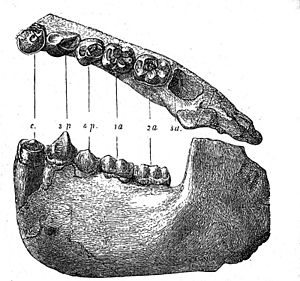Dryopithecini
| Dryopithecini | ||||||||||||
|---|---|---|---|---|---|---|---|---|---|---|---|---|

Pine of Dryopithecus fontani |
||||||||||||
| Temporal occurrence | ||||||||||||
| middle Miocene | ||||||||||||
| 20 to 10 million years | ||||||||||||
| Locations | ||||||||||||
| Systematics | ||||||||||||
|
||||||||||||
| Scientific name | ||||||||||||
| Dryopithecini | ||||||||||||
| Gregory & Hellman , 1939 | ||||||||||||
| Genera | ||||||||||||
An extinct tribe in the superfamily of the human (Hominoidea) is called Dryopithecini . The Tribus was introduced in 1939 by William King Gregory and Milo Hellman. Due to the low number so far discovered, meaningful fossils is controversial ( incertae sedis ) whether the dryopithecini as tribes of the subfamily Homininae within the apes or attributable to (Hominids) as a separate subfamily (Dryopithecinae). Currently, their members are usually only regarded as the main group representatives of the great apes and therefore counted outside of them as part of the hominoidea.
features
According to David Begun , the species of Dryopithecini were medium to large primates with a body weight of 20 to 45 kg.
Since the relationships between the ape-like fossils from the Miocene, around 20 to 10 million years old, have not been established due to the modest finds , there have so far been different opinions - depending on the respective researcher - about the number of associated species .
For example, in 2009 David Begun classified the three genera Dryopithecus , Rudapithecus and Hispanopithecus - mainly due to their thin enamel layers, which indicate a predominantly frugivorous diet - in the subtribe Dryopithecina (Gregory and Hellman, 1939) and the two genera Ouranopithecus Kau and Graappecopithecus due to their robustness and extremely thick enamel layers - in the newly introduced subtribe Ouranopithecina of the tribe Dryopithecini (that is, exclusively fossil finds from Europe). In 1977, Eric Delson, on the other hand, assigned Dryopithecus as well as Limnopithecus to the subtribe Dryopithecina and Gigantopithecus to the sister subtribe Gigantopithecina, i.e. also fossil finds from Asia and Africa. Other authors also placed Pierolapithecus and Anoiapithecus - two other fossil finds from Europe - in the tribe.
Individual evidence
- ^ William King Gregory and Milo Hellman: The dentition of the extinct South African man-ape Australopithecus (Plesianthropus) transvaalensis Broom. A comparative and phylogenetic study. In: Annals of the Transvaal Museum , Volume 19, 1939, pp. 339-373
- ↑ Isaac Casanovas-Vilara al et .: An updated chronology for the Miocene hominoid radiation in Western Eurasia. Appendix to: Isaac Casanovas-Vilara et al .: Updated chronology for the Miocene hominoid radiation in Western Eurasia. In: PNAS , online publication of March 21, 2011, doi: 10.1073 / pnas.1018562108 , full text (PDF; 312 kB)
- ↑ Terry Harrison, Apes Among the Tangled Branches of Human Origins. In: Science . Volume 327, 2010, pp. 532–534, doi: 10.1126 / science.1184703 (alternative full text access: ResearchGate )
- ^ A b David R. Begun : Dryopithecins, de Bonis, and the European origin of the African apes and human clade. In: Geodiversitas , Volume 31, No. 4, 2009, pp. 789–816, full text (PDF; 2.9 MB)
- ↑ Eric Delson : Catarrhine phylogeny and classification: Principles, methods and comments. In: Journal of Human Evolution , Volume 6, No. 5, 1977, pp. 433–459, doi: 10.1016 / S0047-2484 (77) 80057-2 , full text (PDF; 393 kB)